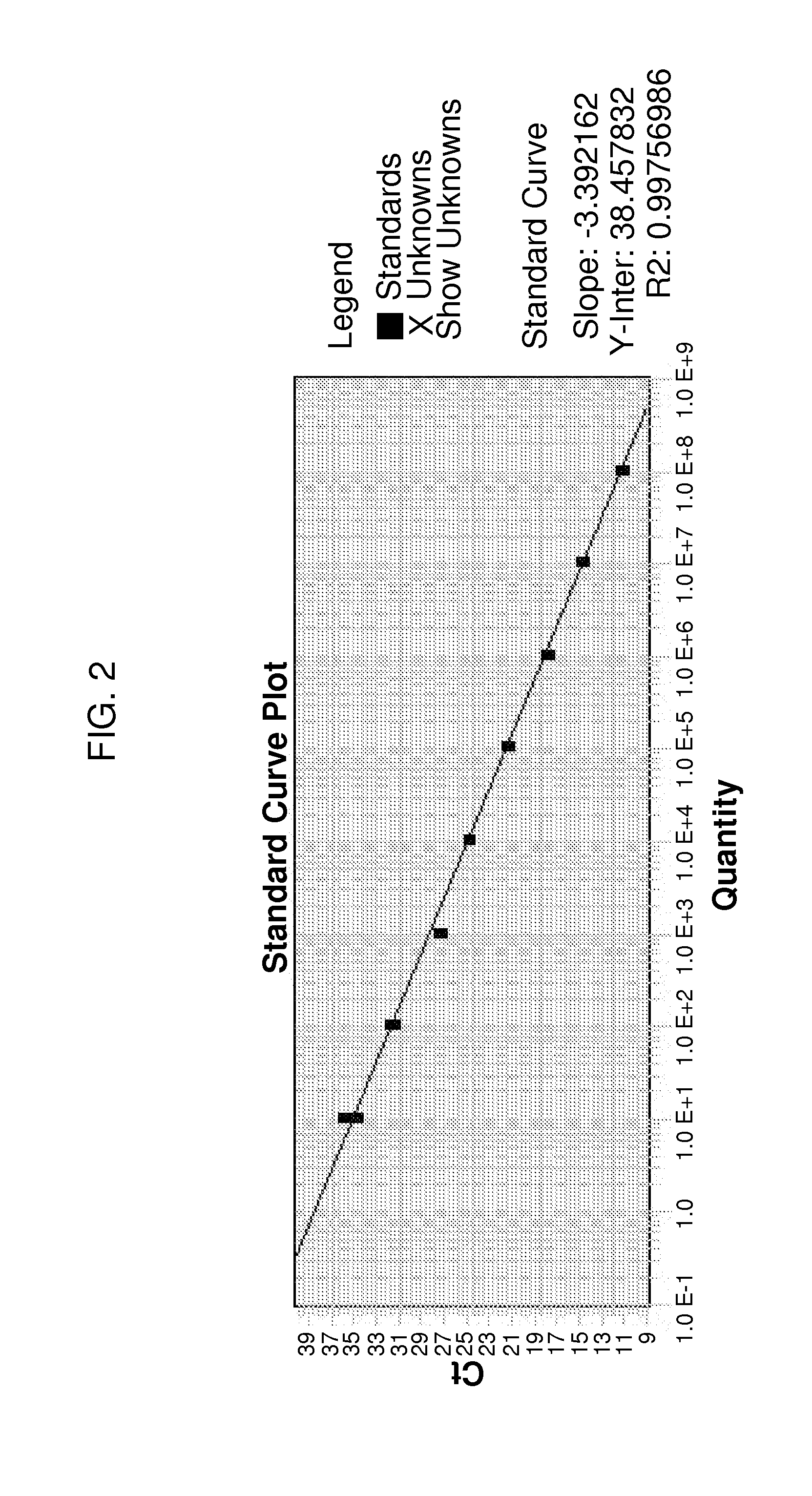Method of detecting coccidioides species
- Summary
- Abstract
- Description
- Claims
- Application Information
AI Technical Summary
Benefits of technology
Problems solved by technology
Method used
Image
Examples
example 1
Coccidioides Relative Quantification in a Sample Using CocciQuant Assay
[0067]CocciQuant assay is highly specific to C. immitis and C. posadasii. The assay detects the ITS region, a multi-copy target having the advantage of being detected at low levels in comparison a single-copy target. Although the copy number of ITS in Coccidioides isolates, including C. immitis and C. posadasii, varies, as disclosed herein, the average number of ITS copies in a Coccidioides genome is around 50 (see Table 7 below). Therefore, the CocciQuant assay detecting copy number of ITS region provides a method for relative quantification of Coccidioides fungal load.
[0068]Synthetic plasmid DNA was used to generate a standard curve for target copy number quantification. Two synthetic plasmids were made by Blue Heron Biotechnology (Bothell, Wash.). Each synthetic plasmid DNA included an ampicillin resistance gene, beta-lactamase (BLA) in the vector, one copy insert of ITS2, along with a copy of sequence contain...
example 2
Specificity of CocciQuant Assay
[0073]To further illustrate the specificity of CocciQuant assay, the assay was tested against a number of differential diagnostic isolates and near neighbor or background isolates. All assay results were negative (see Table 3 and Table 4), indicating the sample species doesn't contain C. immitis and C. posadasii specific sequence amplifiable using CocciQuant assay comprising CocciQuant-F (SEQ ID NO: 2) and CocciQuant-BD-R (SEQ ID NO: 3) primer set.
TABLE 3The assay was tested against the following differential diagnostic isolates.All were negative.Total numberSpeciesscreenedAbiotrophia granulicattella1Acinetobacter baumanni1Acromobacter xylosoxidans1Bacillus spp.2Bacteroides fragilis1Bacteroides uniformis1Bordetella bronchiseptica1Burkholderia cepacia1Burkholderia psuedomallei3Candida albicans1Candida glabrata2Candida parapsilosis3Candida tropicalis1Chryseobacterium1Corynebacterium spp.1Coxiella burnetii2Enterobacter aerogenes2Enterobacter cloacae9Enter...
example 3
Sensitivity and Efficiency of CocciQuant Assay
[0074](1) Determining Limit of Detection
[0075]Also called the Detection Limit, Lower Limit of Detection, or Limit of Detection (LOD), is the lowest quantity of a substance that can be distinguished from the absence of that substance (i.e. a blank value) within a stated confidence limit. LOD is hereby used to describe the sensitivity of CocciQuant assay. Samples comprising DNA of synthetic plasmid having ITS2 were quantified, and limiting serial dilutions were created to test the Limit of Detection. Dilutions were queried across the CocciQuant assay with 20 replicates each. Finally, to establish the LOD, dilutions for which at least 19 of 20 replicates amplified were further evaluated by testing 64 replicates and exhibited at least 95% amplification (61 / 64 amplification ratio) as a confidence limit. Results shown in Table 5 demonstrated that the LOD of ITS2 detection using CocciQuant assay is 5 copies / 2 μl. If the copy number / 2 μl in a sa...
PUM
| Property | Measurement | Unit |
|---|---|---|
| Volume | aaaaa | aaaaa |
| Volume | aaaaa | aaaaa |
| Volume | aaaaa | aaaaa |
Abstract
Description
Claims
Application Information
 Login to View More
Login to View More - R&D
- Intellectual Property
- Life Sciences
- Materials
- Tech Scout
- Unparalleled Data Quality
- Higher Quality Content
- 60% Fewer Hallucinations
Browse by: Latest US Patents, China's latest patents, Technical Efficacy Thesaurus, Application Domain, Technology Topic, Popular Technical Reports.
© 2025 PatSnap. All rights reserved.Legal|Privacy policy|Modern Slavery Act Transparency Statement|Sitemap|About US| Contact US: help@patsnap.com


